SOUTHERN VALLEY TOUR
Cusco • Tipón • Raqchi – The Wiracocha Temple • Pikillacta • Andahuaylillas • Cusco
Half Day
Tipón
Tipon is one of the largely preserved archaeological ruins at about 3,450m altitude and still shows the impressive achievements of the inca empire, which consisted of gardens and temples. While the traces of the population and their settlement date back thousands of years, Tipon has seen its impressive development about 500 years ago, when it served as an independent walled settlement in the immediate vicinity of the inca nobility. The mostly red brick walls of the 12 terrace supports reflect exactly the 12 months of a year.
Inside the settlement are beautifully landscaped squares, canals, decorative aqueducts and a large water fountain, all of which have transformed the mountainside far away from other rivers into a small technical marvel. Tipon was also a place that served the Inca for ceremonial and religious purposes. Today, some of these structures are still recognizable and stand as a sign of the technical irrigation and hydrotechnology that prevailed in the inca empire. Tipon was included in the list of International Historic Landmarks for Engineering Structures in 2006 by the American Society of Civil Engineers.

The inca empire once occupied the regions around Cusco in a special way. This large region was around the ancient andean capitals of the inca – Chinchero and Cusco – in present-day southern Peru and existed for over a century. The inca empire stretched over parts of Colombia, Ecuador, Peru, Bolivia, Chile, and Argentina and was the largest empire in pre-columbian America. The inca were very experienced and tech-savvy engineers and craftsmen who built a vast network of traffic routes connecting the more distant provinces of the inca empire.
The Inca created a great many technically sophisticated systems of rainwater, groundwater and natural springs, which were used to irrigate the fields and secure food for the population. Nowhere is this technology more recognizable than at this archaeological site.
Raqchi – The Wiracocha Temple

Origin and meaning
The name “Raqchi” comes from the indigenous language Quechua and describes a clay pot fired from clay. The origin of the word also describes precisely the main activity of the population of this region, to which this archaeological place Raqchi was located since the pre-hispanic period and from which the inhabitants of this region brought their ceramics to various places in the south of the Andes. The inhabitants of Raqchi’s “ceramists” or “artisans” have always been known and are still very much associated with the ceramic craftsmanship. During archaeological excavations, the researchers repeatedly found many ceramics from pre-hispanic times.
The small farming community Raqchi is located in the district of San Pedro, which belongs to the province of Cusco with the Canchis region. The town is accessible from the road that connects Cusco and Puno, by bus, coletivo or even on foot. It is also on the map on the banks of the Vilcanota river. With its three residential districts, Hanansaya, Urinsaya and Qullana Ayllu, the community consists of approximately 150 families that preserve their cultural identity and ancient structures. The ruins are about 100 km south of Cusco and can be seen from the road. Despite everything, it is therefore quite far from the actual drive of the tourists, and thus largely spared the tourist flow from Cusco.
The Archaeological site “Wiracocha”
According to inca Garcilaso de la Vega, the citadel was built under the inca king Wiracocha. Between 1439 and 1471, during the reign of inca Pachacútec, it was expanded and completed in the third construction phase, according to the spanish conquistador, chronicler and historian Peru’s, Cienza de Leon under the inca Tupanqui between the years 1471 and 1493.
The sanctuary served basic purposes; religious ceremonies were held in honor of the god Wiracocha, who was considered the invisible chief god and became known as “Apu Kon Titi Wiraqocha”. Wiracocha is also considered the creator of the sun, moon, stars, animals, plants, humans and the earth. The place also served as a warehouse for food. Derived from the Quechua language name Wiraqocha is composed of the words “Wira” (water foam) and the word “Qucha” (the personification of the mother lagoon or goddess of water), in the indigenous cross, which is also under the name “Tawa Chakana” (an equilateral indigenous cross) is located. This is worshiped in the constellation “Willka mayu”, and the chakanas are carved in the main walls of the sanctuary.
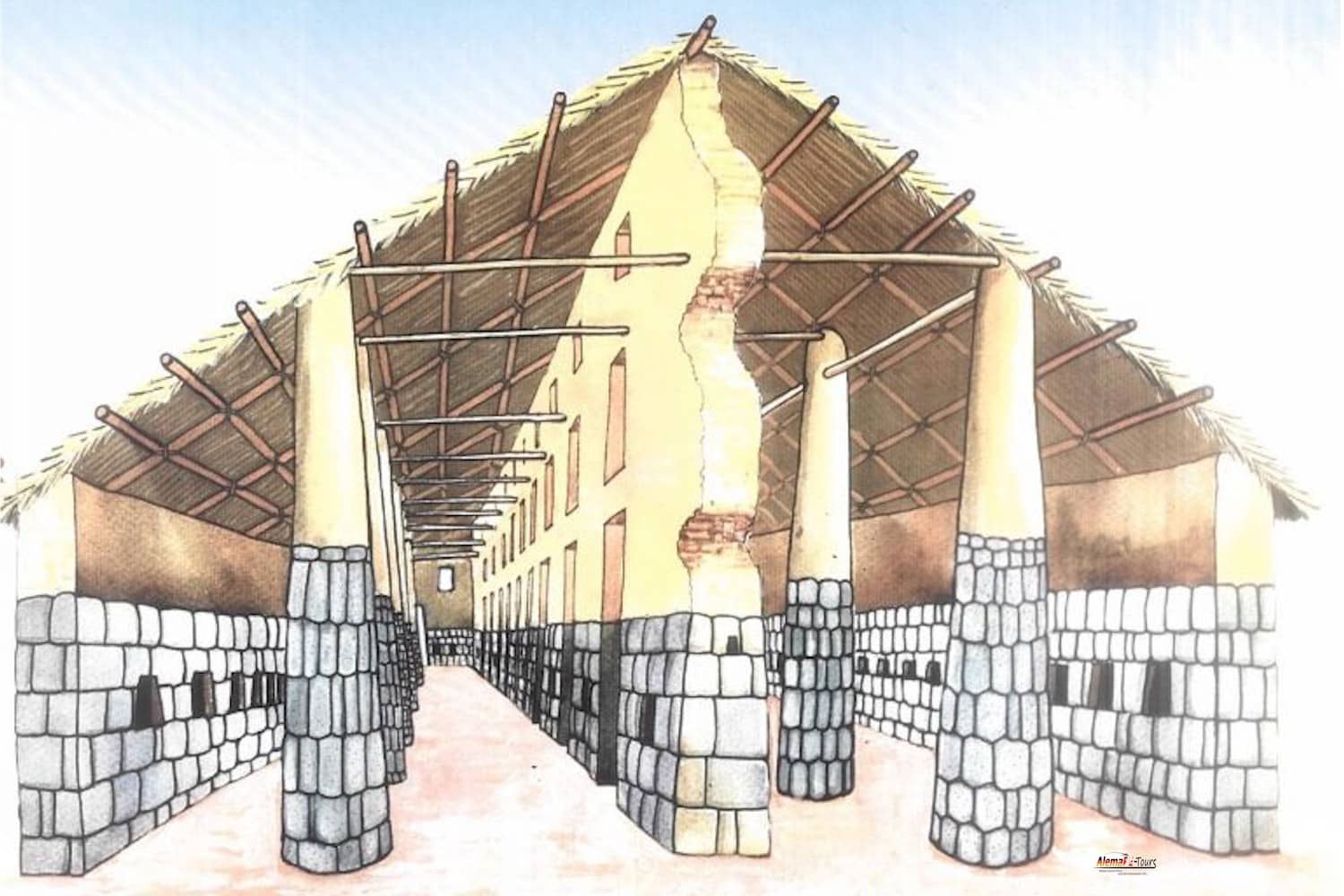
Particularly striking is the wall of mud bricks, which extends in the middle of the building complex up to a height of about twelve meters and thus divides the temple into two equal halves. The stone walls of the temple were built not only from clay, but also from the volcanic rock which was brought specially for the construction. As a result, the walls appear in a very different light than those of other temples. The centrally divided temple of Raqchi is assigned by the researchers of the pre-inca period, in which the Tiwanka culture finds its temporal assignment. Wiraquocha or today also Wiracqua was built according to inca Garcilaso de la Vega along with the citadel-like remnants of the plant under the inca king Wiracocha and therefore still bears his name today. Wiracocha was according to the stories of the Spaniards to one of the most important deities of the andes region around Cusco.
Chakana
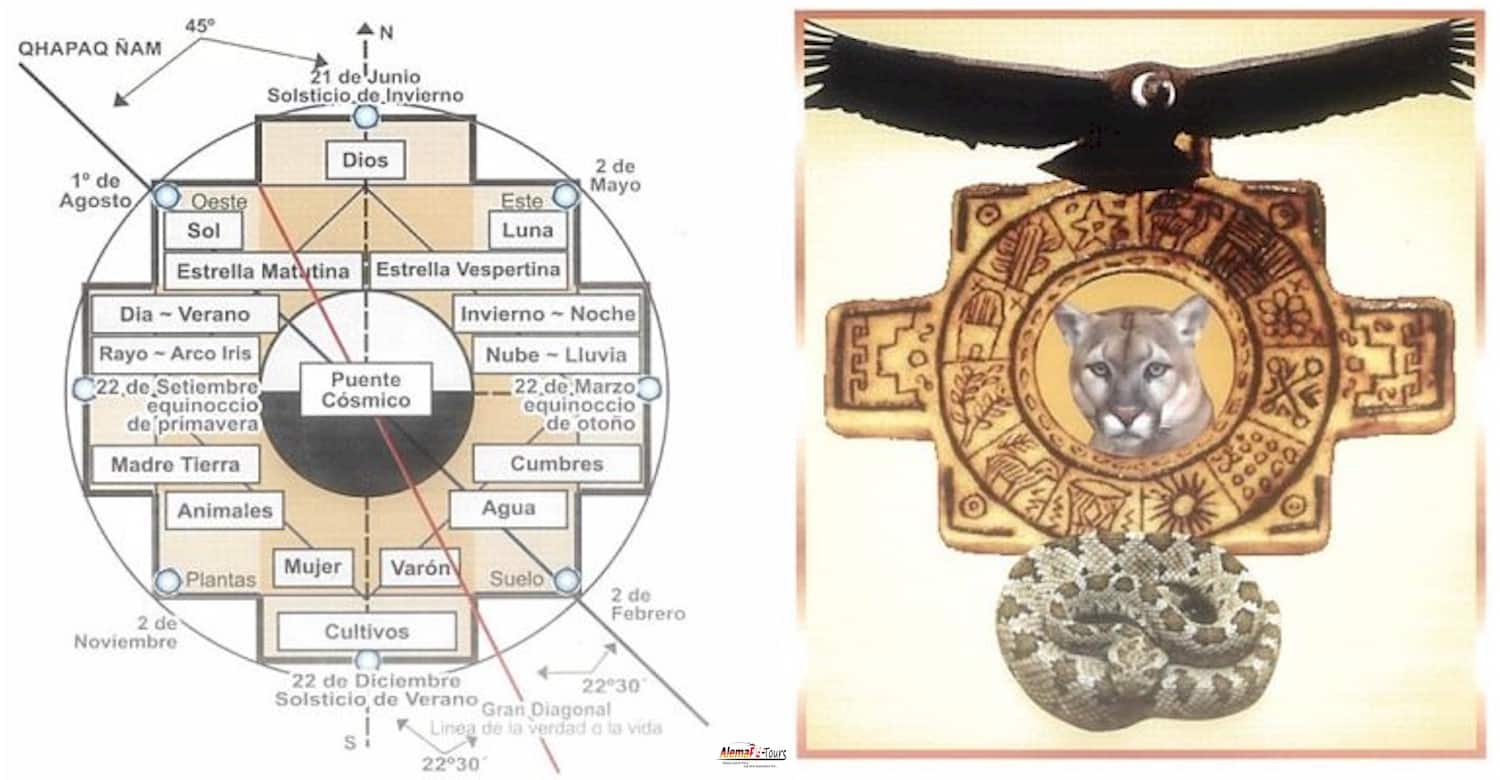
In the andean culture, the holy places were decorated with beautiful figures or decorated. Omnipresent is also the andean cross, which was engraved or made in plaster. In the Wiracocha temple, the cross was plastered with seven steps of the finest clay, representing the seven colors of a rainbow and the seven fixed shapes in the andean worldview of the time: man – woman, sun – moon, mountain – mother earth (pachamama), morning light – light of dusk, lightning – rain, rainbow – wind.
The three worlds of indigenous cosmovision are also embodied as: Hanq Pacha is represented by the “Mallku Kuntur”, the condor, which stands for wisdom and intelligence. For Kay Pacha, the world we all live in, the puma stands as a symbol of strength and tireless zest for action. Ukhu Pacha is represented by Amaru, the serpent who represents the encounter with nature and the deities of the earth or the universe.
The Inka Trail
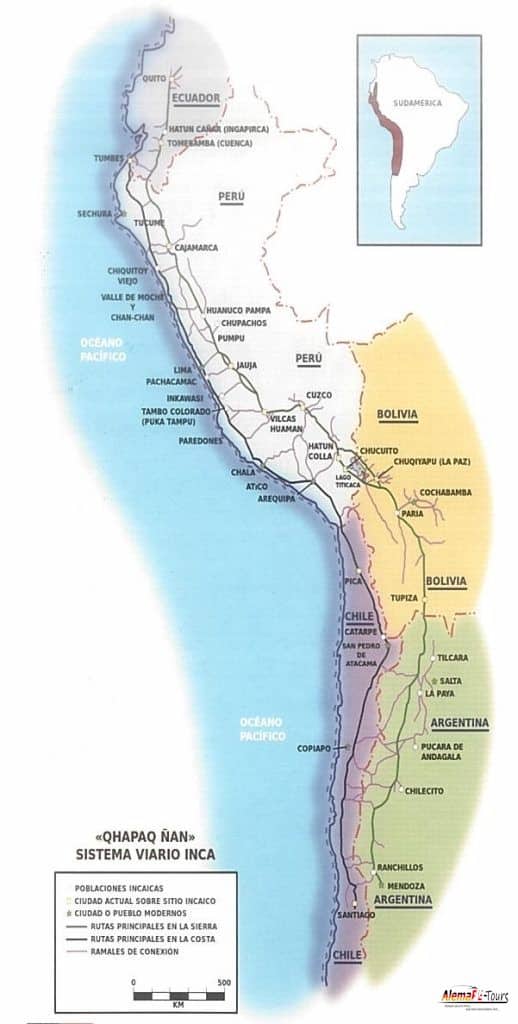
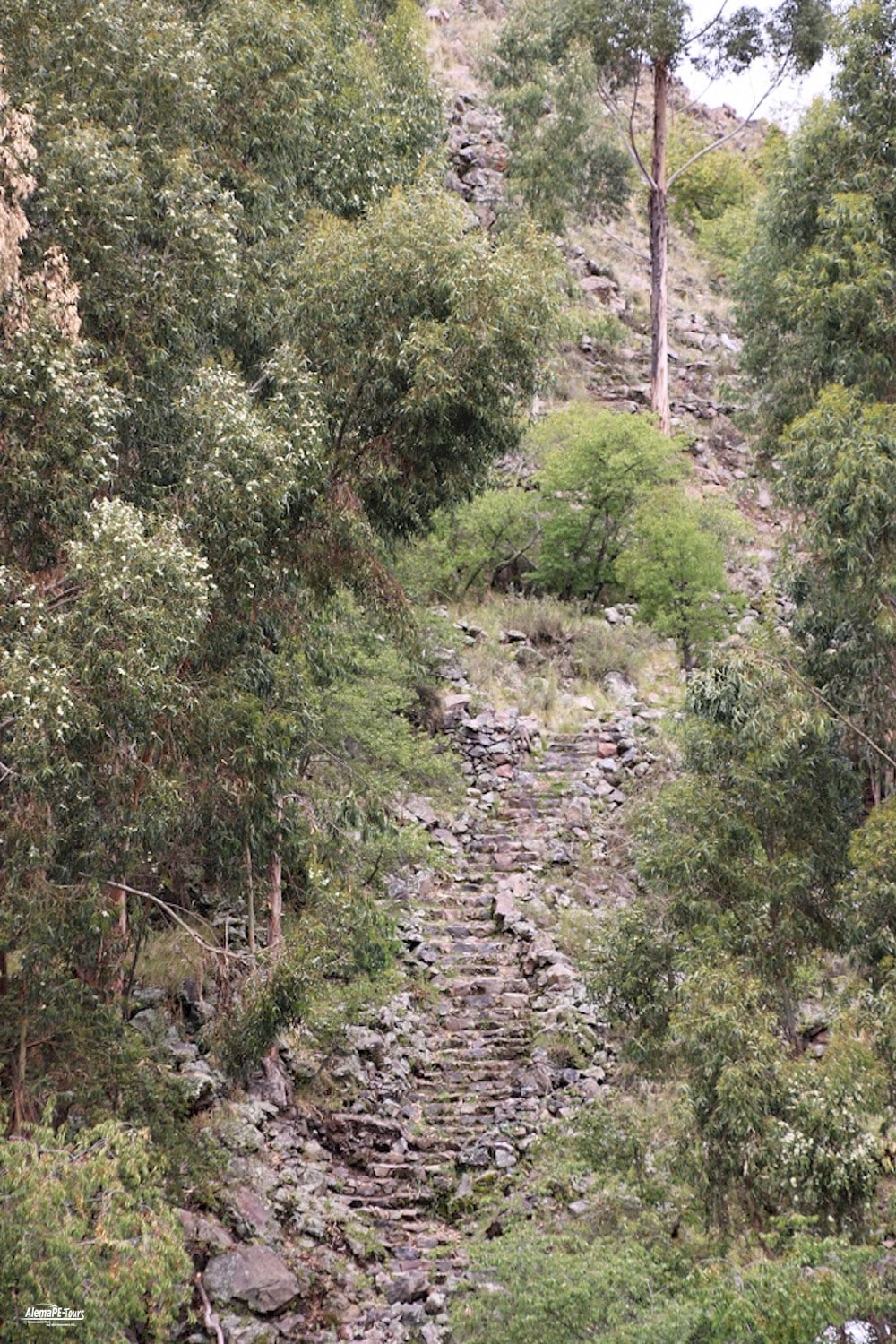
The core area of the plant
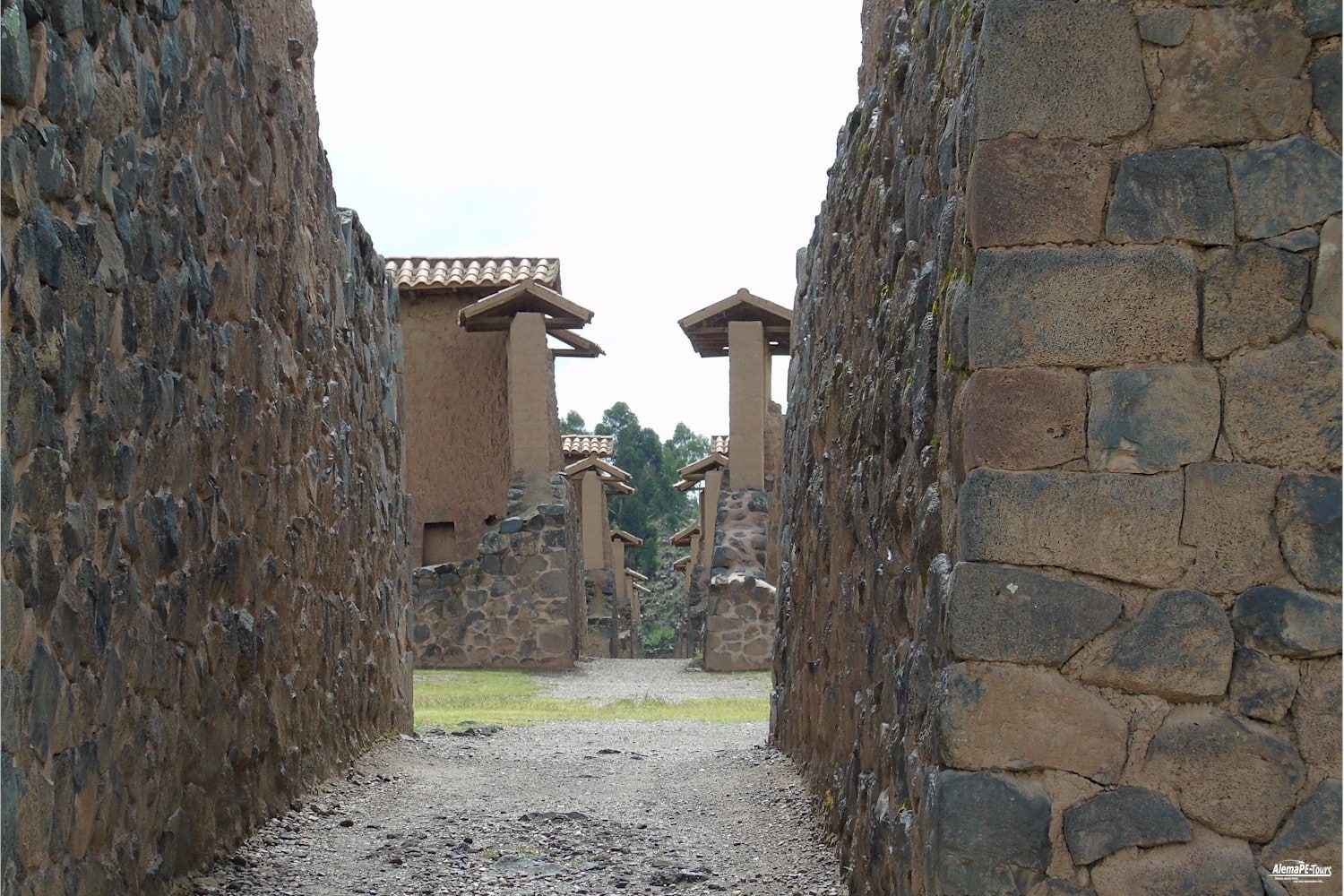
The “Inti Tayta”, which appears at the height of the Apu Awkisa in one of the corners of the courtyard in the morning around 6:45, forms the first rays of sunshine in the streets to form a shadow of about 45 degrees. This shadow connects to the diagonal of the chakana and thus points to the orientation of the planet to the South Pole. It is quite impressive to see how the ancestors of the Inca managed to do so easily and aligned their buildings with the star system. The main street of the complex is after the sunrise and the summer solstice on December 21st. This is also the middle of the year in the Andean calendar.
The dwellings within the temple city were intended for wise people or those selected by the Apus, the deities of the mountains. For example, the “Paqu”, the Andean priest of “Llapa”, was struck by lightning. On special holy days rituals were performed here in the temple, at whose ceremonies also the acting “Raqchi Ayllu” took part.
The Colcas
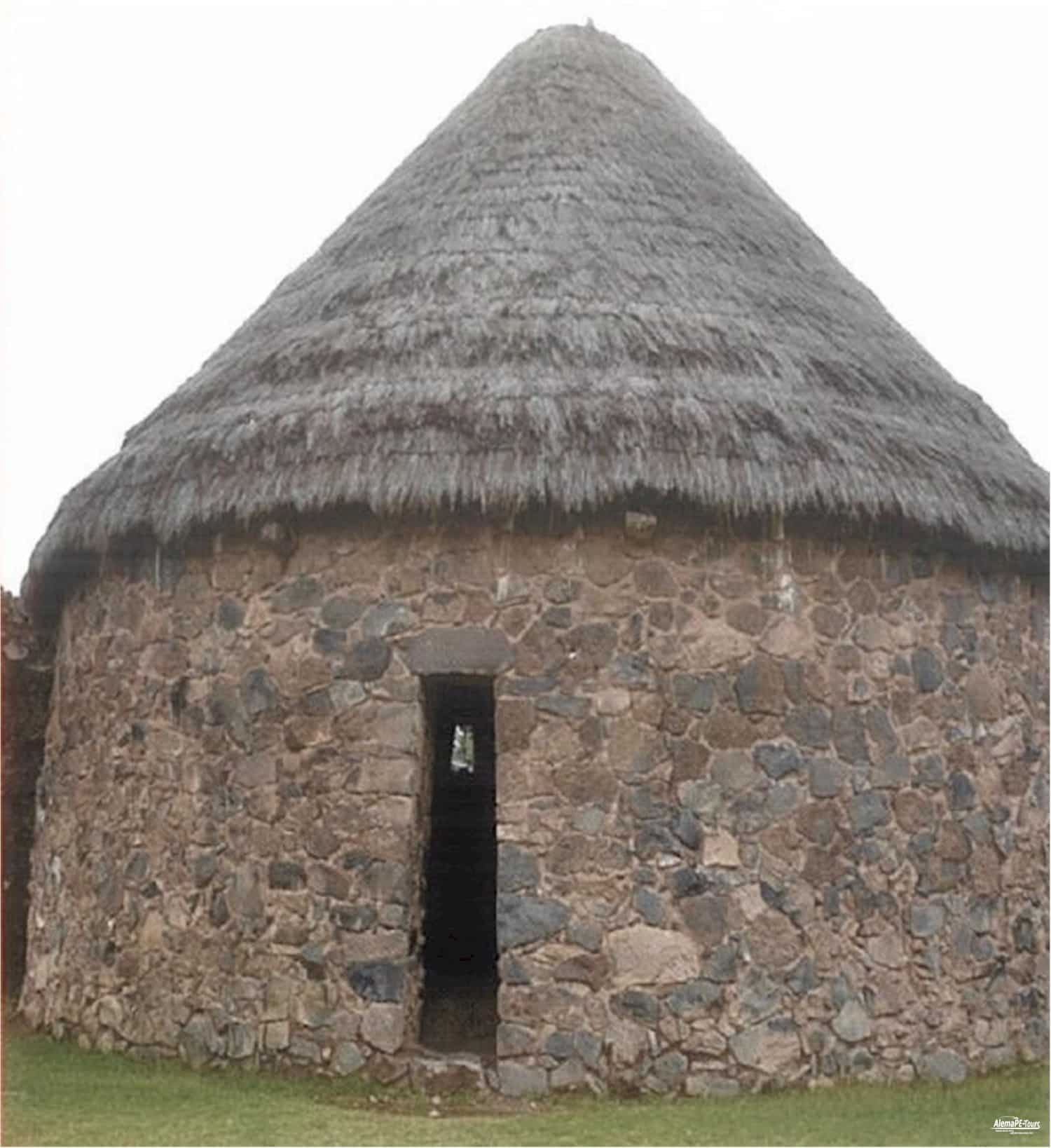 On the south side of the Wiracocha temple there are 156 “Pirqa” round buildings on this site. They were built with a diameter of 8m from coarse volcanic rock and clay mortar. As a result, these buildings were very pleasantly air-conditioned for the residents. An important detail of these buildings, also called “Colcas”, is that they are earthquake resistant and each one is unique to itself. The round buildings were arranged so that they form 10 rows with small alleys in between. Each of these buildings has two small windows for ventilation and a door approximately 2m high and 0.65m wide. The research of various archaeologists has shown that they were originally once covered with a conical roof, the “Ichhus”. The shape of the roofs and buildings also suggests that they once served as granaries or storerooms when the Inca Empire kept large quantities of agricultural produce there. Thus, in the archaeological investigations, traces of maize, various potato varieties, Tarwi, Chuno, etc., and also meat products and also e.g. Chárki, a dried fish found and many other things. The society of Tahauntinsuyo put these for the times of famine and drought, just to be taken care of. Incidentally, the arrangement of the buildings in their grouping also resembles the shape of the constellation of the pleiades (a star cluster from the Milky Way) or “Qullqa”.
On the south side of the Wiracocha temple there are 156 “Pirqa” round buildings on this site. They were built with a diameter of 8m from coarse volcanic rock and clay mortar. As a result, these buildings were very pleasantly air-conditioned for the residents. An important detail of these buildings, also called “Colcas”, is that they are earthquake resistant and each one is unique to itself. The round buildings were arranged so that they form 10 rows with small alleys in between. Each of these buildings has two small windows for ventilation and a door approximately 2m high and 0.65m wide. The research of various archaeologists has shown that they were originally once covered with a conical roof, the “Ichhus”. The shape of the roofs and buildings also suggests that they once served as granaries or storerooms when the Inca Empire kept large quantities of agricultural produce there. Thus, in the archaeological investigations, traces of maize, various potato varieties, Tarwi, Chuno, etc., and also meat products and also e.g. Chárki, a dried fish found and many other things. The society of Tahauntinsuyo put these for the times of famine and drought, just to be taken care of. Incidentally, the arrangement of the buildings in their grouping also resembles the shape of the constellation of the pleiades (a star cluster from the Milky Way) or “Qullqa”.
Usnu and rituals
The Ushnu is a pyramid-shaped construction used by the incas for the conduct of the ceremonies and worship of the gods. There is also concentrated a special magnetic force, which has a positive effect on the strengthening of the consciousness, with which the inca or the respective representative led the ceremonies and the ritual meetings. During the ritual gatherings, drinks were often prepared from the sacred coca leaves and presented to a specific group of people. There is also Wakás, a sacred place dedicated to the Deity of the Rock Mother. The mother of the rock should be so animated, but still remained immobile. Only very specific men and also women from the place Raqchi performed the rituals on the holy days. In the four apartments, which are located on the hill, the so-called “Yachaq” were prepared in the time of Tahauntinsuyo as a sign of a spiritual pooling of forces.
The main ceremony was the mutual communication between the gods of gratitude and the spirits associated with the nature deities, such as the “Apus”, the deities who live in the mountain peaks, the “Pachamama” (mother earth and goddess of fertility) , as well as the “Wakás” (These include: The sun, the moon, the stars, the lightning, the water and the hail). The offerings included selected coca leaves called “k’intus”, chicha (fermented beer from corn), “untu” (alpaca fats), wine, “Huayruros” (a colorful red-black seed), corn and others. This ritual serves to mediate between the divine and human worlds and is carried out in the months of august, february, but also other times.
The Holy Fountain Springs
The so-called “Bath of the Incas” consists of five small waterfalls, which were worshiped. The “Unv mama” is the “waká” or goddess of the water, the mother of all life. The vital and crystalline fluid that springs from the sacred lagoons of Apu Awkisa and Inka Puhu symbolizes the spiritual cleansing of the people who gather in Raqchi and become spiritual and spiritual before entering the places of ceremonies had to wash. Two of these waterfalls follow the solstices and the three others continue to communicate with the “chakana” (the indigenous cross).
The chapel of Raqchi and the souvenirs in the entrance area
The first stories of the record name the building as a chapel of the archangel Michael already in a time about 300 to 350 years ago. Edilfonso Mamani and Marcos Arósquipa Rodriguez are responsible for the construction of the Hanansaya Tower, built by Manuel Amaru. The latter then took over the construction of the Urinsaya tower. All three were born in Raqchi and were higher stonemasons.
For the construction and the acquisition of the volcanic rock one used “Ayni” or the system of the common agricultural work. The women spread the food and holy chicha. The location of the chapel was decided uniformly. Now the chapel is between 300 and 350 years old and houses two virgins and a catholic saint: De las nieves, the archangel Michael and Rosario. Their respective religious ceremonies will take place on 5th august, 29th september and 17th and 18th october. Typical dances are performed, including Quyache, Kate Wayna, Auqa Chileno and Qhapaq Qulla.
Pikillaqta
Pikillaqta is located about 25 km southeast of Cusco on the way between Cusco and Puno. From the road you can hardly see the plant, because it is about a kilometer away from her. If you plan on spending about half a day exploring the entire facility, you’ll be able to see much better, and get an idea of what this place used to be like when the Wari were here.
One can combine the visit of the ruins of Pikillaqta with another archaeological site, namely Tipon, as both lie in the same direction. So it pays to leave early in the morning for Pikillaqta to experience the sunrise or dawn break there and then continue to Tipón.

It is interesting to move on the narrow streets between the former buildings. The color of the stones and the way they were put together to make the very high-impact walls leave an enormous impression, because such a construction technique, as from the Wari period, is unknown in and in Europe.
The whole complex of Pikillaqta is located at about 3.350 m above sea level and covers an area of about two square kilometers. This pre-inca city with its buildings of about 700 buildings and fortifications was probably built and inhabited between 550 and 1100a.Chr.. The city has a geometric design and is divided into blocks with straight streets.
Andahuaylillas
Andahuaylillas has two big tourist attractions:
The “Sistine Chapel” of America
The San Pedro Church of Andahuaylillas is the major attraction for visitors and because of the quality of the artwork, it is considered as the “Sistine Chapel” of America. It was constructed for the Jesuits at the end of the 16th and the princes of the 17th century. Its´ architectural structure is typical for small towns´ churches. Its´ walls are wide, typical for the colonial buildings, made with sun-dried bricks of mud, a facade decorated with murals and two stone columns projected towards the main entrance. Although its´ architecture is relatively modest, the decoration of its´ interiors is the most impressive of the building.

We can first mention a picture of the “Virgin of the Asunción”, painted by the Spanish historical painter Esteban Murillo. You will also see walls attributed to Luís de Riaño (17th century). Who represented the election of man by glory? They attributed this painter, the paintings that decorate the bases and a notable oil of the archangel San Miguel.
The church lodges, additionally, a linen cloth collection of the Cusqueña School, which represents the life of San Pedro (with impressive frameworks in bread of gold), a majestic organ, a silver goldsmith and a baroque altar.
La Plaza de Armas of Andahuaylillas
The immense Plaza de Armas is surrounded by leafy pisonay trees (or choral trees) and palm trees. It is considered as one of the most beautiful Plazas of the region. At a few kilometers from here is the place called Huaro, where the wizards lived at the time of the Incas, or so is said. This is a circuit that will show us a magnificent landscape and will give you moments of satisfaction, getting to know the great variety of typical dishes of the region of Cusco. One of these dishes to taste is the Chicharrón (pork meat) or the famous designated dish ‘Roasted Guinea pig’. We will return to Cusco at about 5.00pm.

South Valley of Cusco Circuit Itinerary
We will pick you up at your hotel at 9:00 am. First, we will visit the archeological site of Tipón. A great place to observe several royal chambers of the Inca Wiraqocha. This type of architecture is well known for its imperial style and impressive hydraulic engineering in magnificent mountain scenery. In spite of the years the construction style of the channels and the liturgical sources are still intact, in honor to the goddess of the water.
After this, we will continue to the old village of Pikillacta. This was one of the more impressive regional centers of the Wari culture, seated in Ayacucho, in which the Incas through the years occupied. Today it is a national archeological park of great importance.
The word Pikillaqta is a made up Quechua word, meaning lousy town (piki = lousy, llaqta = town), although it is also called “city of the fleas”. The constructions of Pikillacta exist of more than 200 kanchas (apartments), 504 golgas (warehouses) and other constructions. The city must have accommodated a population of approximately 10 thousand people.
Some investigators suggest that during the Inca times, Pikillacta was a city for “mitimaes” (groups of people or tribes who were being transferred from place to place).
The next tourist attraction will be Andahuaylillas, a small village at 3,198m (10490 feet), having a good climate because of the surrounding mountains. It is located 35 km (22 miles) southeast of Cusco on the road that leads to the Puno region. Formerly, the name of this village was Antawaylla, (anta: barrel maker; waylla: prairie and both words united mean “coppery prairie”).
Price
Please contact us to get the price of this tour.
Tour-ID
CUZ015
Duration
Half Day
Included
- Private tourist transport.
- Professional guide in English or Spanish.
- Entrance to the archeological complexes (General boleto tourístico).
- Lunch in the sacred valley of the Incas “Restaurante Tunupa or Sol y Luna”.
Not included
- Guide in English and Spanish on sites.
- Tourist transport.
- Entrance to the archeological complexes.
- Typical regional lunch.
